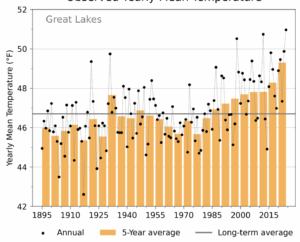ELPC Press Release
Ludington, MI
July 16, 2025
In recent years, our planet has experienced some of the warmest temperatures ever recorded, record-breaking weather extremes, powerful storms, increasing tragic flooding from rising sea levels and associated storm surge, huge wildfires, and continued melting of glaciers and polar sea ice. The accelerating pattern of changes affect communities around the globe, but they are also is affecting us here at home. Climate change is causing significant and far-reaching impacts on the Great Lakes and the Great Lakes region.
In 2019, ELPC published a special assessment by leading university research scientists that examined the current and projected impacts of Climate Change on the Great Lakes and the surrounding region, drawing from an array of existing research. In this new 2025 update, the scholars are back to highlight new observations, research, and lessons learned over the past six years. They found that the 2019 assessment continues to be a sound, valid examination. Continuing to update, assess, and understand how climate change impacts the Great Lakes region is important to policymaking and advancing resilience.

Observed Yearly Mean Temperatures are rising in the Great Lakes states of MN, WI, IL, IN, MI, OH, PA, & NY
The Midwest is Warming: Since 1951, annual average air temperatures have increased by 2.9°F in the U.S. Great Lakes region (GLISA 2025). Moreover, since the 2019 report, the Midwest has already warmed another two-thirds as much (1.1°F) as it did in the decades before that (1.6°F), so warming is accelerating.
We cannot take the vast natural resources of the Great Lakes for granted. Scientific analyses clearly show that climate change has already greatly affected the region and that these impacts will continue and expand as the pace of climate change accelerates. More than 40 million people rely on the Great Lakes for drinking water, fisheries, recreation, commerce, and industry, all of which are impacted by climate change. The lakes sustain more than 170 species of fish and habitats for over 3,500 species of plants and animals, many of which are rare or found nowhere else. People value this unique region for its ecological diversity, economic opportunity, and invaluable cultural importance. For all these reasons, we must reduce the effects of climate change on the Great Lakes.